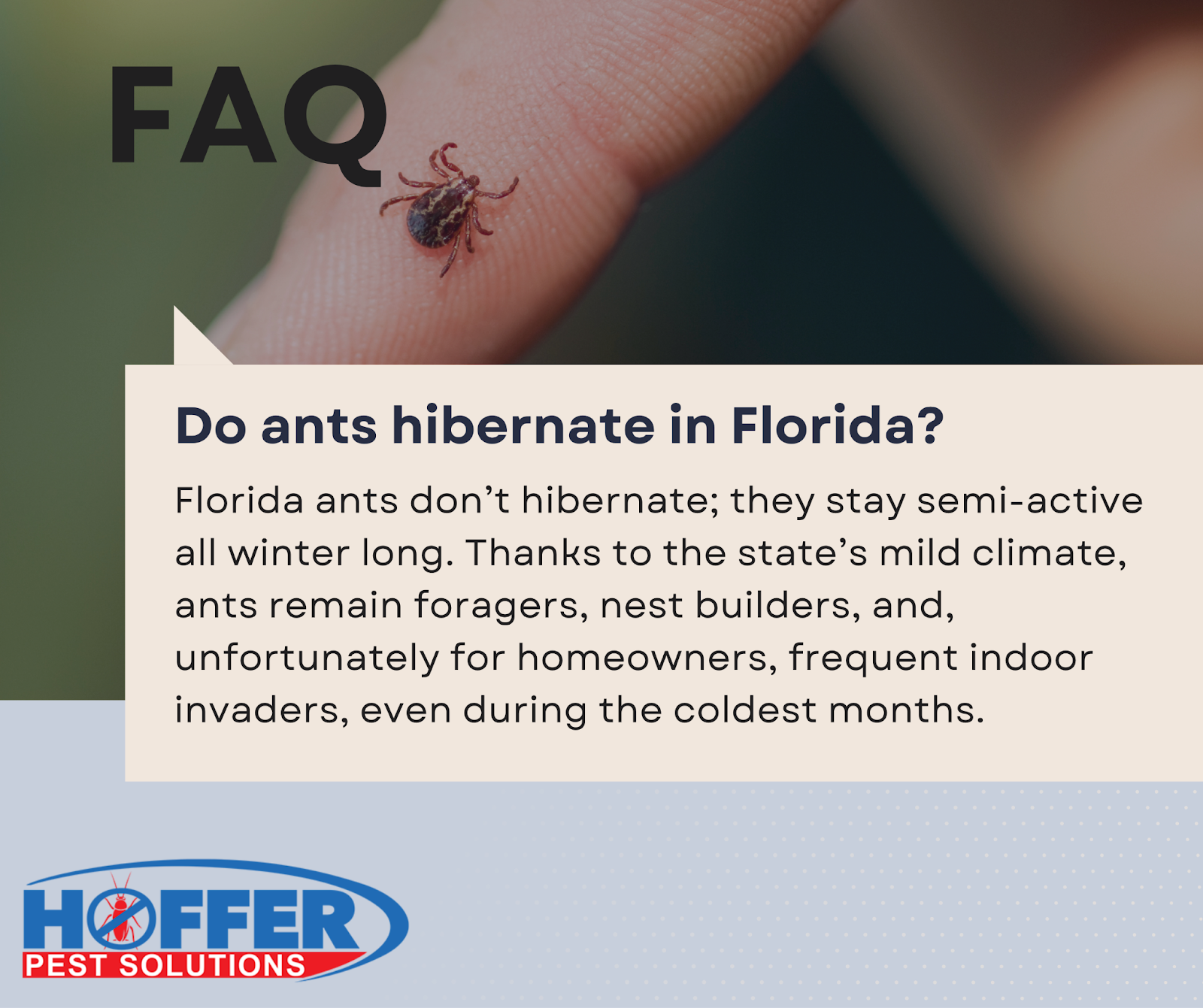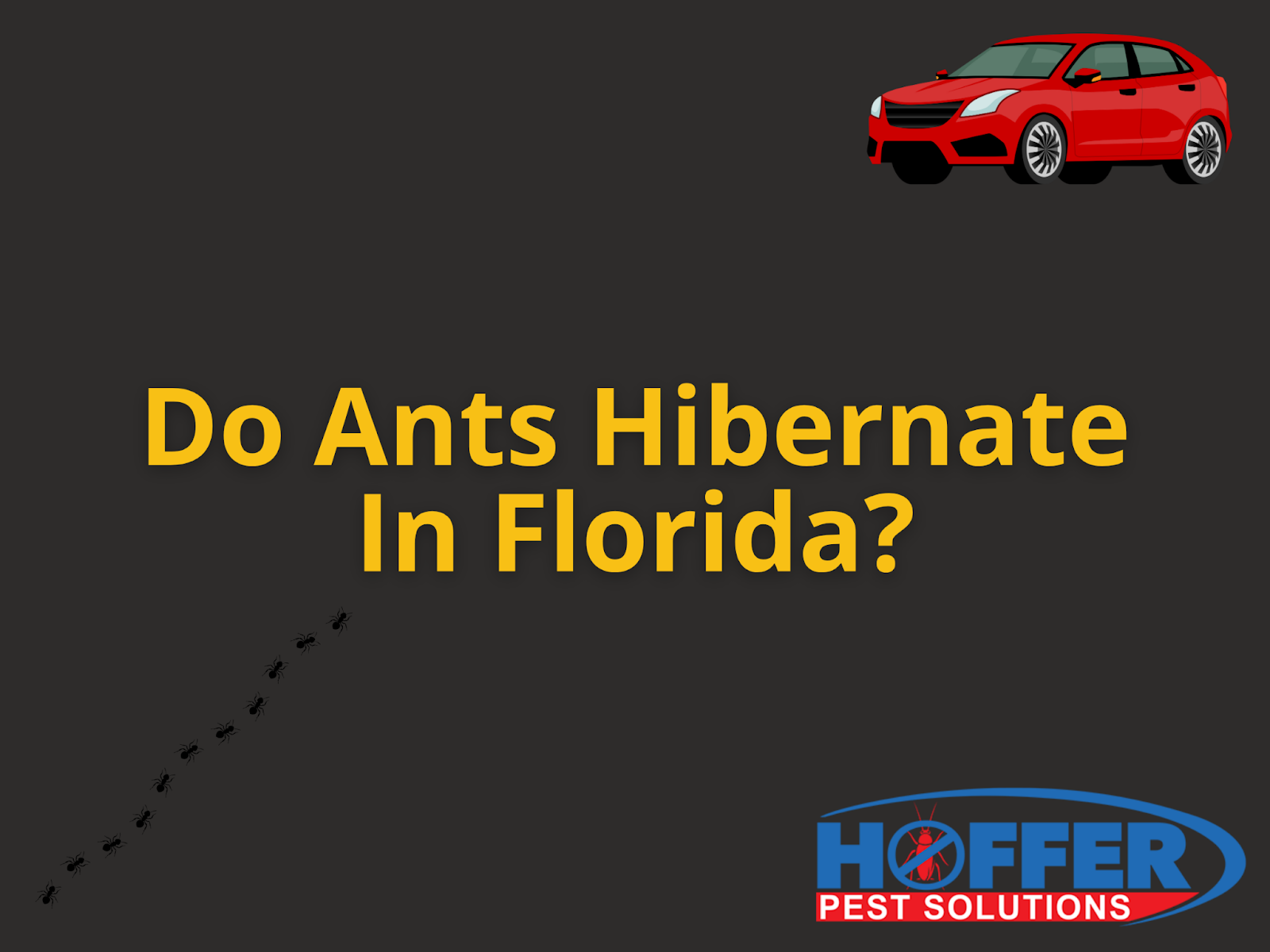Florida ants don’t hibernate; they stay semi-active all winter long. Thanks to the state’s mild climate, ants remain foragers, nest builders, and, unfortunately for homeowners, frequent indoor invaders, even during the coldest months.

Key Points About Winter Ant Behavior in Florida:
Ants slow down but never fully shut down (no true hibernation)
Indoor nesting increases near warmth, moisture, and food
Common winter-active species include carpenter ants and ghost ants
Cooler temps drive ants into bathrooms, kitchens, and wall voids
That’s where Hoffer Pest Solutions comes in. With decades of experience and eco-friendly methods, we help Florida homeowners prevent and eliminate ant problems, no matter the season.
Keep reading to understand why ants stick around all year and how to protect your home before a minor nuisance becomes a full-blown infestation.
Do Ants Hibernate in Florida?
Ants do not truly hibernate in Florida. Instead, they may enter a mild rest period known as diapause. Unlike hibernation, which involves a complete metabolic shutdown as seen in some mammals and temperate insects, diapause is more of a slowdown.
Ants remain semi-active, still foraging and maintaining colony functions at a reduced pace.
Florida’s subtropical climate, particularly in central and southern regions, rarely drops below 50°F for long. This temperature threshold is generally required to trigger true dormancy. As a result, many ant species in Florida remain active all year. Even in northern parts of the state, where temperatures can flirt with that threshold, ants often find warm, insulated spots to continue functioning.
Some species might slow down slightly. For example, Camponotus floridanus and Pogonomyrmex badius may reduce egg-laying or exhibit sluggish movement during cooler months. However, this behavior still falls short of full hibernation.
Many ants shift to nesting just beneath mulch beds, behind walls, or under flooring where conditions remain warm and stable. These protected micro-environments allow them to bypass temperature drops and continue their life cycle uninterrupted.
The key takeaway is that Florida ants don’t disappear when winter arrives.
They adapt to their surroundings, stay mobile in milder conditions, and often become more visible indoors. Homeowners should be aware that what seems like a seasonal lull is often just a change in nesting location, not an end to the problem.
Species-Specific Winter Behavior in Florida
Florida is home to a wide variety of ant species, each with slightly different responses to the state's mild winters. While none of them hibernate in the strictest sense, their winter behavior is shaped by species-specific traits and local microclimates.
Florida Carpenter Ant
Camponotus floridanus, commonly known as the Florida carpenter ant, may enter a light diapause in the cooler months. This doesn't mean complete inactivity. Instead, egg production may temporarily slow, and workers might reduce foraging. However, they remain responsive to warmth and food availability and can quickly resume normal activity when conditions stabilize. These ants do not require hibernation to survive winter in Florida.
Big-Headed Ant
Pheidole megacephala, also known as the big-headed ant, is a tropical species often found in South Florida. These ants are particularly vulnerable to cold and do not tolerate refrigeration or artificial chilling well. Attempting to induce hibernation by lowering their temperature can lead to colony stress or even death. For this reason, keeping tropical ants like these at stable, warm indoor temperatures is critical during winter.
Harvester Ant
Pogonomyrmex badius, Florida’s native harvester ant, displays one of the most temperature-sensitive patterns. In North and Central Florida, they may exhibit a short resting phase. This light diapause must be carefully managed, especially in captivity. A gentle temperature reduction to around 60–70°F may support natural rhythms, but sudden cold or refrigeration should be strictly avoided.
Why Ants Invade Florida Homes in Winter
While ants in northern climates retreat deep into the ground to avoid freezing temperatures, Florida ants take a different approach. Even a modest drop in temperature can encourage them to move indoors. This is especially true when nighttime lows dip into the 50s, which, although mild by northern standards, can be enough to make ants seek warmer shelter.
Once inside, ants look for spaces that offer protection, warmth, and steady access to food or water. Florida homes, particularly those with aging seals, gaps in foundations, or moist environments, become ideal habitats. Common nesting spots include behind interior walls, along bathroom plumbing, beneath tile flooring, and within small crevices near kitchen appliances. These areas are consistently warm, humid, and rich in resources like crumbs, pet food, or standing water.
Ants don’t need freezing temperatures to relocate. A drop of just 10 degrees in outdoor conditions may prompt colonies to expand into more stable environments. This leads many Florida residents to wonder, “Why do I suddenly have ants in the bathroom in January?” The answer lies in the ants’ instinct to survive. Bathrooms offer the trifecta: heat, moisture, and seclusion. Combined with climate-controlled indoor air and a lack of predators, it's no surprise these spaces become winter hideouts.
Prevention Tips: Keeping Winter Ants Out

Preventing ant invasions during winter in Florida requires proactive effort. While the temperatures might not be freezing, ants will still look for optimal conditions, and it’s up to homeowners to remove those opportunities.
Outdoor Prep
Begin with the exterior of your home. Ants often find their way inside through tiny cracks and gaps that are easy to overlook:
Seal cracks and entry points in your home’s foundation, walls, and around utility lines. Even the smallest crevice can serve as a highway for ant foragers.
Install weather stripping and door sweeps to prevent ants from entering under exterior doors or window frames.
Store firewood and garden debris away from the house. Woodpiles provide nesting environments and warmth, attracting ants close to your structure.
Indoor Maintenance
Once inside, ants typically stay if they find resources. Good sanitation and environmental control can make your home less appealing:
Eliminate excess moisture, particularly near sinks, bathtubs, and windows. Repair leaky faucets or pipes promptly.
Store food in airtight containers, especially sugary or greasy items. Even a small spill can attract an entire trail of ants.
Clean up crumbs, spills, and pet food quickly. Floors and countertops should be wiped down regularly, and trash bins should remain sealed.
Your Winter Ant Strategy in Florida
Ants in Florida don’t take the winter off, and neither should your pest prevention. Even when activity seems low, colonies may be nesting behind walls, under floors, or near moisture sources inside your home. Acting early helps stop small problems from becoming springtime infestations.
Hoffer Pest Solutions offers trusted, year-round ant control tailored to Florida’s unique climate. With expert inspections and eco-friendly treatments, we help you stay one step ahead.
📲Contact us today to protect your home this season, and every season.
Frequently Asked Questions
Do Florida ants hibernate in test tubes?
Most Florida-native and tropical ants do not require hibernation, even when kept in artificial housing like test tubes. In fact, introducing hibernation conditions to these species can do more harm than good. A slight slowdown in activity may occur if room temperatures drop slightly, but no specific hibernation setup is necessary for most colonies.
Is mold during winter dangerous for my colony?
Yes, mold growth can be a serious threat, especially in confined setups like test tubes or formicariums. With ants staying more stationary during mild diapause, moisture buildup becomes more likely. Ensuring proper ventilation and replacing moldy setups promptly is important to prevent health issues or colony collapse.
Should I keep feeding ants during cold months?
Absolutely. Even during reduced activity, ants continue to consume carbohydrates and, to a lesser extent, protein. Carbohydrate intake in particular helps maintain energy levels and supports mild foraging behavior. Removing food entirely may lead to unnecessary stress or starvation.
Can winter rest boost spring colony growth?
In some species, a short period of reduced activity can act as a reset. It allows the queen to conserve energy and can result in a burst of productivity when conditions warm. However, this effect is subtle and varies by species, with no formal hibernation phase required for healthy spring development.


